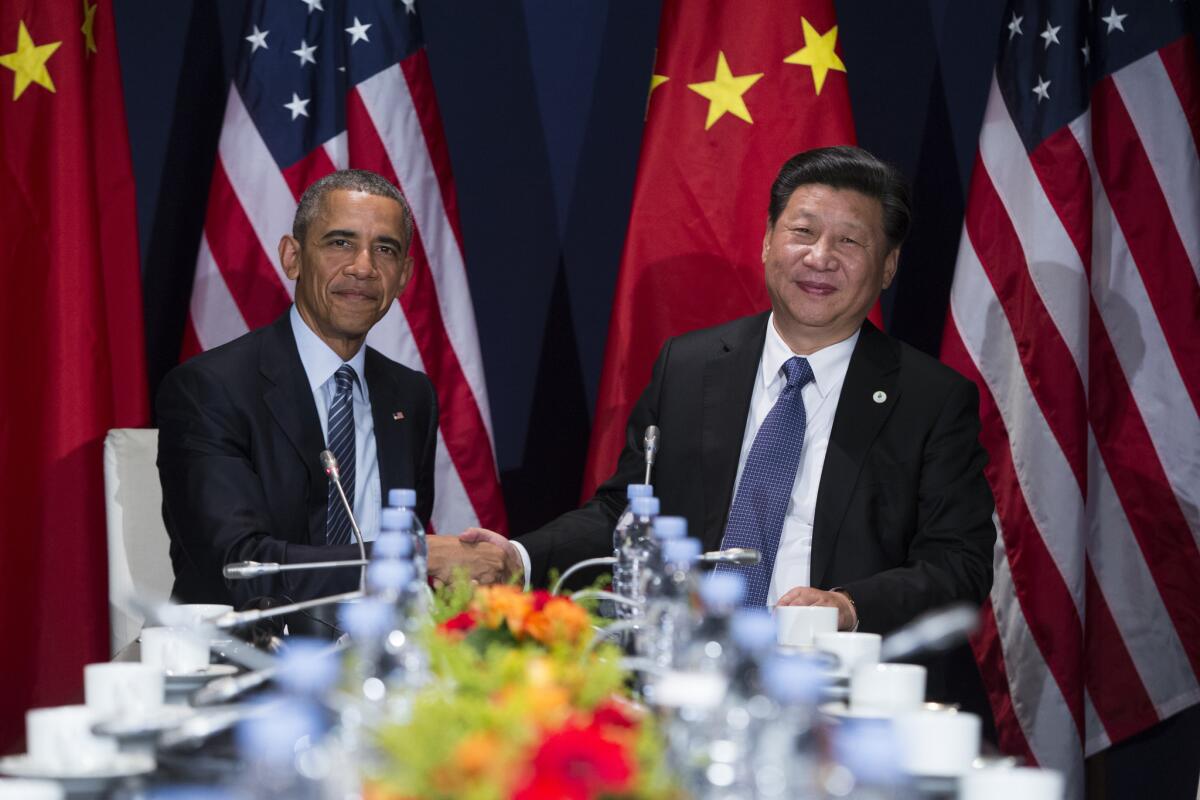How Obama learned from ‘a mess’ of a climate deal to forge a new agreement in Paris

President Obama meets with Chinese President Xi Jinping during the United Nations climate change summit on Nov. 30.
Reporting from Paris — Hoping to salvage a faltering international climate deal, President Obama’s team roamed the halls of a Copenhagen convention center in 2009 “hunting for the Chinese,” as then-Secretary of State Hillary Clinton recently put it.
Securing a commitment – any commitment – from China, the world’s leading emitter of carbon gas, would be key to the face-saving, if disappointing, agreement that emerged.
“A mess,” deputy national security advisor Ben Rhodes bluntly labeled the Copenhagen summit.
There were no search parties necessary in France on Monday as Obama opened a similarly crucial United Nations summit on climate change sitting beside Chinese President Xi Jinping, declaring that the two superpowers “come here with a common vision for what’s needed in a Paris agreement.”
The Obama administration’s years-long effort to preordain success at this global gathering – which included careful diplomacy that yielded a breakthrough agreement with China last year to reduce carbon emissions – reflects the degree to which Obama learned from his early setback in Denmark. He applied those lessons toward fighting climate change, a signature goal he has pursued as he tries to cement his legacy in his final years in office.
The failure in Copenhagen to achieve agreement on emissions wasn’t the only hindrance to the president’s climate agenda in his first term. A cap-and-trade plan to limit emissions barely passed the House in 2009 only to stall in what was then a Democratic-controlled Senate. Ultimately, the president chose to focus most of his energy on dealing with Congress on his landmark healthcare law and keeping the economy afloat after the Great Recession.
Nevertheless, Obama appeared determined to act on climate change before the end of his presidency. In his second inaugural address, the issue figured prominently as he declared that Americans have an obligation “not just to ourselves, but to all posterity.”
“The path towards sustainable energy sources will be long and sometimes difficult. But America cannot resist this transition; we must lead it,” he said from the steps of the U.S. Capitol.
The president began to forge a path that would set aside obstacles and marshal support from other world leaders.
Obama pursued progress with tools more firmly in his control than another legislative proposal would have been – primarily the regulatory authorities of the Environmental Protection Agency, and foreign policy.
When heads of state or elected leaders visited Washington, or Obama traveled to a foreign capital, the agenda almost always included a major announcement on combating global warming with an eye toward building momentum for a Paris accord. A visit by Brazilian President Dilma Rousseff in June, for instance, included an announcement of her country’s new goals to halt deforestation and increase renewable energy production 20% through 2030.
On a trip to Southeast Asia in November, Obama again prodded developing nations to set similarly ambitious goals. At one point, he played a kind of talk-show host role to moderate a discussion between Jack Ma of Chinese e-commerce giant Alibaba and a young Philippine entrepreneur who was seeking more private-sector investment for his invention, a lightbulb powered by saltwater.
“I’m just serving as a matchmaker here,” the president joked.
Obama’s most significant breakthroughs came with China, an occasional adversary but one for whom the imperative of addressing environmental challenges had become more significant since Copenhagen.
In Beijing last year, Obama and Xi jointly committed to reducing emissions: the U.S. to cut net greenhouse gas emissions at least 26% by 2025, and China to accelerate its time frame for carbon reduction while increasing its use of nuclear, wind and solar energy. When Xi visited Washington this fall for a state visit, he announced that China would pursue a cap-and-trade program of its own.
On Monday, Obama credited those pledges with helping to spur significant promises from more than 180 other countries to fight global warming – including developing nations that had been absent from previous accords, such as the one adopted in Kyoto, Japan, nearly two decades ago.
“Our leadership on this issue has been absolutely vital,” Obama said.
The voluntary commitments – in contrast to a deal like Kyoto’s, which imposed binding requirements only on advanced economies – reflect another shift in approach guided by Copenhagen, and the reality in the U.S. that Congress would be loath to enact such commitments into law.
“We had to construct a framework in which everybody could play a role,” Rhodes said Monday, ticking off the steps the White House has taken alongside other leaders since Copenhagen: determining a framework for a deal as well as each country’s commitment and detailing how reporting requirements would work absent legal binding.
“That has been an exhaustive process over the last several years,” Rhodes said.
Obama called Monday for an international pact “that builds in ambition,” an acknowledgment that the voluntary agreements won’t result in the sought-after 2-degree-Celsius limit on global temperature growth, but will provide flexibility where nations could gradually make more robust commitments to limiting emissions.
The administration’s ability to regroup from its early setbacks is a reflection of its own careful planning and a rapidly evolving global consensus on climate, said Jim Kapsis, a vice president for Opower and a former Treasury Department official who was on the U.S. negotiating team in Copenhagen.
“When you see a Chinese leader come to Washington two months ago and announce that China’s going to start a cap-and-trade system in 2017 and a whole array of other commitments, that’s a big deal,” he said. “That was just not possible in 2009.”
It’s also a sign of an American president racing toward the finish line, as the White House has put it.
“This is not the kind of problem you want to leave for the next generation,” said Brian Schatz, a Democratic senator from Hawaii and one of the Senate’s lead advocates on climate change issues.
But Obama’s agenda still faces stiff resistance from Republicans and some Democrats in Congress. This week, the House plans to vote on a pair of resolutions that would reject regulatory initiatives, including Obama’s so-called clean power plant rule, that are key to fulfilling the commitments the U.S. is making in Paris.
And, as Senate Majority Leader Mitch McConnell (R-Ky.) noted in an opinion piece in the Washington Post as Obama left for Paris, even if Congress or the courts can’t block the president’s course of action, a new Republican president could stop whatever Obama started.
For more White House coverage, follow @mikememoli.
MORE ON THE CLIMATE TALKS
Tech billionaires follow the climate-change money
Climate talks begin in Paris; goal may be hard to reach
Paris climate summit could bring historic deal on emissions, but likely won’t halt climate change
More to Read
Sign up for Essential California
The most important California stories and recommendations in your inbox every morning.
You may occasionally receive promotional content from the Los Angeles Times.











